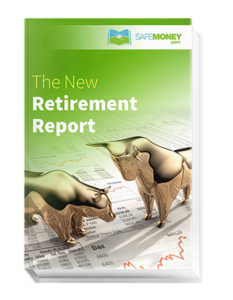Retirement Planning
From SafeMoney.com
As you get closer to retirement, you want to be sure that you are ready for a smooth transition into your post-career lifestyle. There are several things that you can do ahead of time to help yourself with this goal.
To make it digestible, here is a breakdown of different things to do and think about at every stage of pre-retirement.
Retirement Planning Steps 10 Years from Retirement
At this point, it’s prudent to take stock of your retirement assets to make sure that you are still on track for your financial goals.
Are you saving enough for retirement? Or will you have to make “catch-up” contributions to your retirement savings so that you can keep up your ideal lifestyle in later years? Now is a good time to ask these questions and evaluate your progress.
It’s also an ideal point to start having conversations with your spouse or partner about what you both want in retirement. Do you want to travel? Pursue a second-act career or open a business you have long dreamed of having? Having these discussions now can bring clarity to each of your individual financial goals and to your overall financial direction.
Another point is the question of taxes. As you have built up savings in your retirement accounts and maybe an employer retirement plan, chances are at least some of your money have grown in a tax-advantaged manner. When you start taking withdrawals from the accounts is crucial, as taxes will be due and can affect how much income you end up with.
You will want to start preparing for tax bracket planning for when you begin taking money from your retirement accounts for an income stream. Part of that might include exploring ways to potentially reduce your long-term tax burden in retirement.
Apart from your nest egg, it’s also good to go over household debts, such as the mortgage. Determine when you might have them paid off. Will it be prior to retirement? At some point into your retirement years?
If you don’t have a financial advisor, this would be a good point to find one. Take some time to do your research and speak with a few different financial professionals to see what they can offer you and with whom you feel most comfortable.
As you can see, taking stock of your financial situation at this point spans many areas: retirement, taxes, debt management, and more. You might want to have a comprehensive financial plan done to see where you will end up financially by the time you retire.
Retirement Planning Steps 5 Years from Retirement
Now you are deep into what financial professionals call the “red zone” in terms of planning for retirement. If you sustain losses in your portfolio at this point, then it may be hard for you to make them back up in the short term. This potential situation is called “sequence risk.”
Insofar as retirement planning, now (or even earlier) is a good time to start planning for your income streams in retirement.
How much will your ideal lifestyle cost you per year? What sources of income will you have to fund your lifestyle? How much income can you count on receiving from your retirement assets each year? How much will healthcare expenses and potential long-term care costs run you?
When might you run out of money in retirement? What can you do now to guard against that risk with confidence in later years?
These are important questions that it’s good to work through, ideally with the guidance of an experienced financial professional.
One important point: Don’t think about your retirement money in terms of an overall savings target for how much you might need, but rather how much monthly income you can generate from your assets over time. That can help bring clarity to your financial picture.
You still have some time until your expected retirement date, but now is also a good time to consider moves for tax-efficient planning if you haven’t made them yet. For instance, you might consider Roth conversions of existing retirement accounts.
While you will pay taxes upfront, your tax bracket could well be lower now than in years ahead. What’s more, the IRS also has certain rules for Roth accounts, such as the 5-year ownership rule of the account before you can tap it for tax-free income, to account for.
You also need to start thinking about what you will want to do with your company-sponsored retirement plan after you stop working. If you found a financial advisor within the last five years, then they will probably be able to show you a few options that could work for you.
Retirement Planning Steps 3 Years from Retirement
Now that you are nearing retirement, you should explore financial strategies that can help preserve and protect your retirement money. The options available to you here will depend on your risk tolerance and other details of your personal situation.
Diversification is a strong guard against market risk and the different ways that it can impact your future lifestyle, so now is a good point to start having discussions with your advisor about this.
Sequence of return risk has started to play a major role in your investments, so it’s also prudent to pay attention to what the markets are doing.
If you haven’t thought about your legacy goals yet, you might also start considering, by this point, what you hope to pass onto your heirs. Be sure to review your wills, trust documents, and beneficiary designations on your accounts, insurance, and other assets to ensure they are in line with your legacy wishes.
These items should also reflect any major life changes, such as divorce, marriage, new additions to the family, or other happenings.
Retirement Planning Steps 1 Year from Retirement
By now, your retirement portfolio will likely be closer to resembling what your post-retirement portfolio will look like. Again, your financial strategy at this point should be based on your personal goals, needs, risk tolerance, and overall situation.
Speaking at a high level, here are a few things to consider. Your financial plan will need to keep up with inflation, so that you can maintain your standard of living. Part of your strategy should include growth to offset inflation over time.
On the other hand, you also need reliable income in retirement, especially for your monthly lifestyle expenses. Depending on your situation and income level, you might consider guaranteed income streams to supplement Social Security – or even to maximize the amount of dependable income you are receiving each month.
Now, what about Social Security and Medicare? This is also a good time for you to start thinking about those programs, and how you are going to cover your medical expenses after you stop working.
Whether you will stay in your present home after you retire is another major factor to consider. If you want to stay where you are, then experts advocate trying to have it paid off before you stop working.
Should you want to downsize, then you can divert the profit from your sale towards retirement savings. What if you need additional guaranteed income to meet your lifestyle expenses? Then you might consider diverting some of that money into vehicles that can offer a predictable income stream.
A non-qualified annuity may be worth a look here. After all, annuities are the only thing besides Social Security that can pay you a guaranteed lifetime income.
Retirement Planning Steps 5 Months from Retirement
At this juncture, you have hopefully made the changes that you need in order to transition smoothly into retirement.
Is your house paid off yet? If so, then your retirement dollars will stretch much further. If not, then you can map out a plan to get it paid off according to a timeline that is efficient and yet makes sense for you.
After all this, what if you still won’t have enough money to make ends meet in retirement? Apart from downsizing your retirement expectations, and assuming your house is paid off, then you might consider tools like a reverse mortgage or home equity loan.
This is also probably the time to get your hands on whatever paperwork you will need in order to do something with your employer plan over after you retire. If you plan on a second-act career after you retire from your current profession, then now is right to get things lined up with your new employer.
You might be able to start the pre-employment process right now, depending on the circumstances. Or, you may want to leave a space of time between your current job and your next one as a chance to rest and regroup before beginning your second career.
Retirement Planning Steps 1 Month from Retirement
As D-Day draws near, it’s time to fill out your rollover paperwork and have a plan for what you will do to retain health insurance coverage after you leave your current job.
Should your spouse still be working, you might explore health coverage options that might be available via their workplace. If you have been thinking about Medicare (and have reached or are on the brink of age 65, where you are eligible for it), you might also work with your insurance professional to have your Medicare coverage in place.
Be sure you have enough money saved to make the premium payments for the time you intend to step back from your career (or the time between your first and second careers).
Only one month away from ‘freedom.’ Make sure to pat yourself on the back, you have worked hard to get here!
Retirement Planning Immediately After Retiring
Congratulations, now you are ready to enjoy the fruits of your life’s work. If you haven’t yet, now is time to decide about what to do with your employer retirement plan.
. This is your new normal, and it’s a good time to solidify your cash-flow and spending numbers with a ‘real,’ tangible budget that builds on all of your prior income planning.
Putting a Comfortable Retirement Within View
There you are. Those are the basic steps that you will need to take in order to have a comfortable, successful retirement.
Don’t be afraid to explore insurance and financial strategies as options that might seem “off the beaten path” compared to financial strategies you used in your early career days. Some of these options can bring more peace of mind as well as stability and predictability to your financial future.

